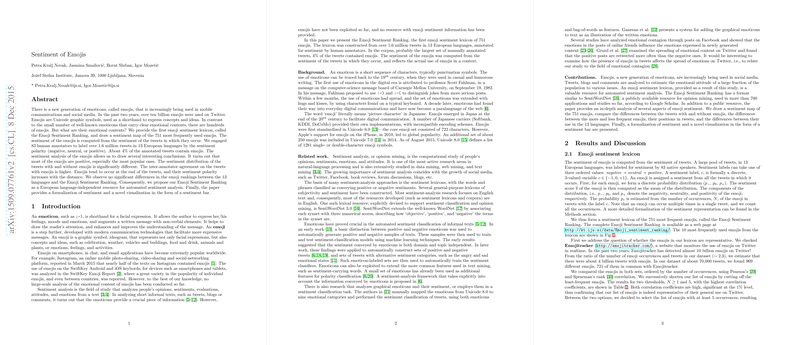Sentiment of Emojis
Overview
The paper by Petra Kralj Novak, Jasmina Smailović, Borut Sluban, and Igor Mozetič presents "Sentiment of Emojis," an in-depth paper aimed at deciphering the emotional content of emojis used in social media, particularly on Twitter. The main contribution of this research is the creation of the Emoji Sentiment Ranking, a sentiment lexicon comprising 751 frequently used emojis. This lexicon enables a nuanced understanding of how these graphical symbols convey emotions within text, extending the scope of traditional sentiment analysis methodologies that primarily rely on textual cues.
Key Contributions
- Emoji Sentiment Lexicon: The Emoji Sentiment Ranking is the core artifact of the paper. It was constructed from a dataset of over 1.6 million tweets in 13 European languages, manually annotated by 83 native speakers. This cross-linguistic analysis found that 4% of these annotated tweets contained emojis. Sentiment scores for each emoji were derived based on their contextual usage in tweets, specifically using the sentiment labels of the containing tweets.
- Sentiment Distribution:: The paper reveals that most emojis are predominantly positive. This was confirmed through a statistically significant difference: tweets containing emojis averaged a sentiment score of +0.365 compared to +0.106 for tweets without emojis. Furthermore, the position of emojis in tweets tends to influence their perceived sentiment, with emojis occurring more frequently at a tweet’s end showing higher sentiment scores.
- Inter-Annotator Agreement: The presence of emojis enhances the inter-annotator agreement, suggesting that emojis provide a clearer emotional cue than the surrounding text alone. Three measures were applied: Krippendorff’s Alpha-reliability, Accuracy, and F1-Score for positive and negative sentiments. All measures demonstrated higher agreement levels for tweets with emojis.
- Cross-Language Uniformity: The Emoji Sentiment Ranking demonstrates robustness across the 13 languages studied. High correlation coefficients between the sentiment scores in specific languages and the overall Emoji Sentiment Ranking suggest that the ranking holds universally for European languages, making it a valuable resource for multilingual sentiment analysis tasks.
- Emoji Usage Analysis: Most frequently used emojis are more emotionally charged compared to less frequently used ones. The standard deviation in sentiment scores among high-frequency emojis is smaller, implying consistent positive sentiment.
Practical and Theoretical Implications
Practical Implications
The Emoji Sentiment Ranking serves as a vital resource for automated sentiment analysis systems. Given its language-neutral nature within European contexts, it simplifies the integration of emoji sentiment data into existing NLP pipelines, enhancing their accuracy and emotional nuance. Additionally, sentiment analysis systems can leverage this lexicon to improve human-computer interaction, customer feedback interpretations, and social media monitoring tools.
Theoretical Implications
The formalization of sentiment properties for emojis opens new research avenues in emotional AI. It supports the hypothesis that non-textual elements like emojis have a profound impact on the sentiment conveyed in social media. This work encourages further exploration into how non-verbal cues contribute to computational sentiment analysis.
Future Work
Future research could explore extending the Emoji Sentiment Ranking to non-European languages and integrating new emojis as they emerge. Moreover, investigating the temporal evolution of emoji sentiment, as new cultural phenomena and meme dynamics evolve, could provide deeper insights into the digital communication landscape. Another promising direction is to analyze the combined effects of emojis and textual sentiment features to develop more sophisticated emotion-detection models.
In conclusion, the construction of the Emoji Sentiment Ranking and the derived findings underscore the critical role of emojis in digital communication. These insights not only enhance current sentiment analysis methodologies but also lay the groundwork for future advancements in understanding and interpreting emotive content in social media.
